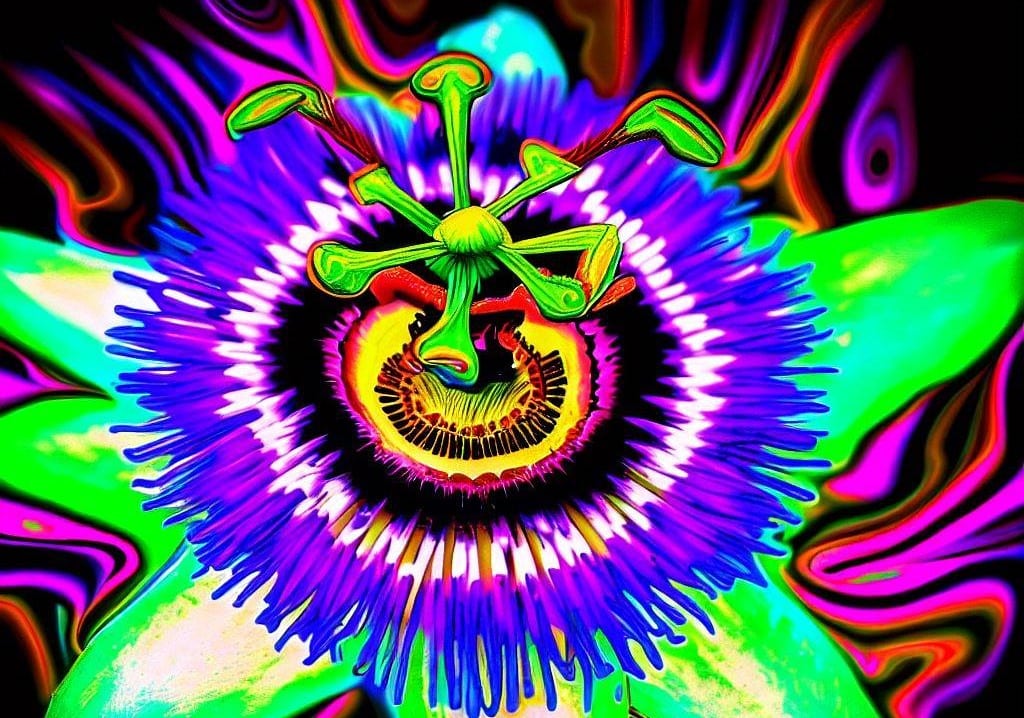What is psiloflora?
During a psiloflora ceremony, psiloflora is served, which causes a psychedelic trip. Psiloflora is a unique blend of psilocybin-containing truffles or mushrooms and passion flower, a mild MAOI. Psilocybin is a powerful psychedelic substance that can induce altered states of consciousness that can promote healing, growth and transformation. Psilocybin can help you access your subconscious, release emotional blocks, gain insights and connect with your true self. Passionflower is a natural herb that can enhance the effects of psilocybin by prolonging, deepening and clarifying the trip. Passionflower can also reduce anxiety, calm the nervous system and promote relaxation. By combining psilocybin and passionflower, psiloflora provides a synergistic effect that can make your psychedelic journey more enjoyable, meaningful and beneficial.
Spiritual psiloflora ceremony
There are several reasons why clients who participate in the psiloflora ceremony often report more spiritual and mystical experiences than with the truffle ceremony. Firstly, the psiloflora ceremony often contains higher doses of psychedelic substances than the truffle ceremony, which lead to more intense and profound experiences for some people. The strengthening effect of the passion flower on psilocybin also contributes to the depth of the trip. In addition, the passion flower has a sacred status in various cultures and the plant is often used in religious and spiritual rituals. Customers often choose the psiloflora ceremony with the intention of gaining a mystical experience. We then help with the preparation to adapt where a spiritual character is present.
Difference with psilohuasca
Psilocybin is responsible for the hallucinogenic effects of both psiloflora and psilohuasca. MAOi, or monoamine oxidase inhibitors, are substances that slow down the breakdown of certain neurotransmitters, psychedelics, so that they remain active for longer and therefore have a greater effect. Both psilohuasca and psiloflora are combinations of psilocybin and an MAOi, which are used for spiritual and therapeutic purposes. The combination of psilocybin and MAOi strengthens and prolongs the effect of psilocybin, allowing the user to have deeper and more intense experiences.
Psilohuasca is prepared by combining psilocybin-containing mushrooms or truffles with a MAOi-containing plant that is often used with ayahuasca, the Banisteriopsis Caapi. Psiloflora is prepared by combining psilocybin with milder MAOi from the passion flower, Passiflora Incarnata. The advantage over psilohuasca is that psiloflora has less risk of increasing blood pressure, causing interactions with other medications or foods, and causing physical discomfort. Psiloflora also does not require a strict diet before or after ingestion, as psilohuasca does.
The power of the passion flower
Passionflower has been used for centuries by the indigenous peoples of the Americas as a sedative and sleep inducing agent. Also in Europe, passion flower was introduced as a folkloric medicine for anxiety, nervousness, insomnia and epilepsy.
Passionflower is beneficial to health because it contains various bioactive substances that have a beneficial effect on the nervous system, cardiovascular system, immune system and skin.
The most important MAOi in passiflora incarnata are harman, harmin, harmaline, harmol and harmalol. These substances have a structural similarity to serotonin and can bind to the serotonin and GABA receptors in the brain. This gives them a calming, relaxing and antidepressant effect. These indole alkaloids mainly inhibit the MAO-A subtype, which is involved in the breakdown of serotonin and norepinephrine.

Another MAOI in passiflora incarnata is chrysin, a flavonoid that also has anti-inflammatory and antioxidant effects. Chrysin mainly inhibits the MAO-B subtype, which is mainly involved in the breakdown of dopamine and phenylethylamine. This gives chrysin a stimulating, cognitively improving and neuroprotective effect.
Psiloflora vs. psilocybin
Psilocybin is seen as the psychoactive substance that causes the psychedelic effects. Although psilocybin has a psychoactive effect, it is relatively small compared to psilocin. Psilocin occurs to a lesser extent in mushrooms and truffles, but oxidizes faster than psilocybin. Most effects come from psilocybin, which is converted to psilocin after ingestion. This process occurs when psilocybin is metabolized by the body. This causes a molecule to lose its phosphate group, resulting in the formation of psilocin.
Psilocin has a similar structure to psilocybin and serotonin and can easily cross the blood-brain barrier. This allows it to bind to the serotonin receptors in the brain, leading to its hallucinogenic effects.

After conversion from psilocybin, psilocin is more sensitive to the oxidation processes catalyzed by naturally occurring MAO enzymes. Oxidized psilocybin and psilocin lose their psychoactive effect. An MAO inhibitor such as in passion flower keeps the MAO enzymes occupied, so that psychedelics remain active for longer and relatively less of them are needed. An additional advantage of psiloflora are the aforementioned soothing effects that provide a calm, dreamy trip.
Contraindications psiloflora
Bee psiloflora we should investigate whether it is suitable for participants in a psiloflora ceremony. First, the contraindications for psilocybin still apply since psilocybin is part of the mix. In addition, there are restrictions on the use of the passion flower.
- Pregnancy
- Kidney diseases
- Diabetes
- Epilepsy
- Neurological disorders
- High bloodpressure
- Heart and vascular disease
- Brain hemorrhages
- Adrenal gland complaints
- Abnormal blood cells
- Schizophrenia
- Psychosis sensitivity
- Borderline
- SSRi: citalopram (Cipramil®) – escitalopram (Lexapro®) – fluoxetine (Prozac®) – fluvoxamine (Fevarin®) – paroxetine (Seroxat®) – sertraline (Zoloft®) etc…
- SNRi: Venlafaxine (Efexor) – Duloxetine (Cymbalta) etc…
- TCA: mitriptyline (Tryptizol®) – clomipramine (Anafranil®) – imipramine – nortriptyline (Nortrilen®) etc….
- Benzodiazepines: oxazepam (Seresta), – diazepam (Valium) – alprazolam (Xanax) etc…
- Anti-asthmatic agents
- Medicines for high blood pressure: (methyldopa, guanethidine, reserpine)
- Buspirone
- Levodopa
- Opoids (in particular dextromethorphan (found in cough syrup, among other things), tramadol!) morphine and codeine
- Remedies for colds, nasal congestion and cough syrups (if available). dextromethorphan or sympathomimetics contain) (Otrivin® and others)
- Sibutramine (remedy for obesity)
- Sympathomimetics. (amphetamines, cocaine, methylphenidate (Ritalin®, Concerta® and Equasym®), dopamine, adrenaline, norepinephrine, isoproterenol)
- Psychedelics such as LSD, MDMA, Ketamine and all other mind altering substances
- Weed or Marijuana
- Amphetamines
- Anesthetics
- Ephedra and other strong weight loss agents
- Iboga/Ibogaine (stop taking it a month in advance)
Psilohuasca/Ayahuasca diet
Although the MAOi from psiloflora are mild and in 99% of cases no adjusted diet is required, we still recommend following a tyramine-restricted diet. This is the same diet that is also used for psilohuasca and ayahuasca and is even mandatory. Tyramine can be a problem with strong MAO inhibitors.
Tyramine
Tyramine plays a role in the regulation of blood pressure. Too much tyramine in your blood can cause high blood pressure, resulting in complaints such as headaches. Normally you do not experience this problem, because certain enzymes break down tyramine. These enzymes have the collective name monoamine oxidase, abbreviated MAO. When using a lot or strong MAOi, the tyramine content can increase and endanger health.
Tyramine can be formed under the influence of bacteria. bacteria form it from the amino acid tyrosine, which is a building block of various proteins. In products containing proteins that are stored or ripened, the tyramine content increases due to the breakdown of tyrosine into tyramine. As a result, old cheese contains much more tyramine than young cheese. Other food processing, including fermentation, fermentation and smoking, increases tyramine levels.
Tyramine-restricted diet
Avoid the following foods for the 3 days before the ceremony:
- Vegetable: sauerkraut
- Herbs: licorice, St. John's wort and ginseng.
- Meat: raw, smoked or cheese-prepared meat and fish.
- Sliced meats: sliced and processed meats
- Dairy: cheese, unpasteurized milk
- Seafood: trassie
- Bread: sourdough bread
- Soy products: tempeh, soy sauce, fish sauce, Tamri and Worcestershire sauce
- Drink: herbal tea with St. John's wort and/or licorice.
- Alcoholic beverages. All alcoholic drinks.
- Yeast: No Marmite, Tartex, brewer's yeast, bread drink and maggi.
- Ready-made: Everything that is not fresh.
Registration for psiloflora ceremony
Screening
We ask every participant of psychedelic ceremonies to complete the intake. We ask for medical information, intentions and the intake includes a neurotransmitter test. We will examine the information entered and, if we discover any contraindications, we will report them. In some cases, with a minor adjustment, it is still possible to participate in the psiloflora ceremony with or without the addition of passion flower.
We draw up a personal preparation and lifestyle plan after a reservation for the ceremony has been made. We also use the data entered during the online intake for this purpose.
Truffle ceremony
During the psiloflora ceremonies we serve the truffle and passion flower tea separately. Each participant can decide for themselves how much passionflower is added to the psilocybin experience, of course with a healthy dose limit. If you do not use the passion flower addition, it is a normal truffle ceremony. Since 2023, we have left the choice to the customer and every truffle ceremony is a psiloflora ceremony and vice versa.
Would you like more information about the psiloflora or truffle ceremony, which is also called the psilocybin ceremony? Then use the button below.
Truffle ceremony
Psychedelic Loft Schiedam-
18 July 2025
-
19 July 2025
-
20 Aug 2025
-
20 September 2025
-
18 October 2025
-
15 November 2025






